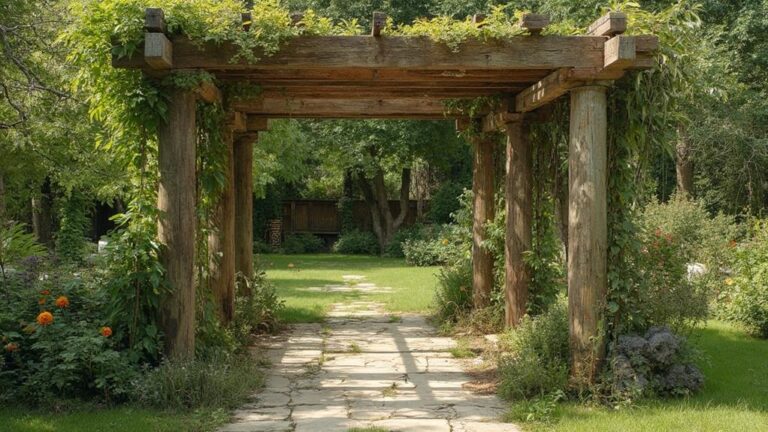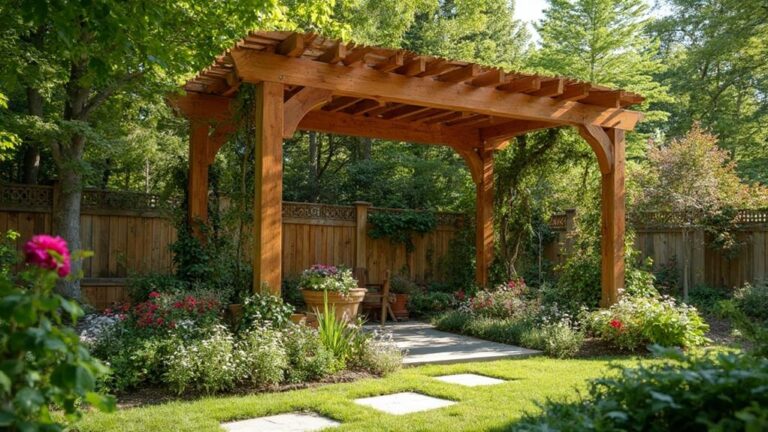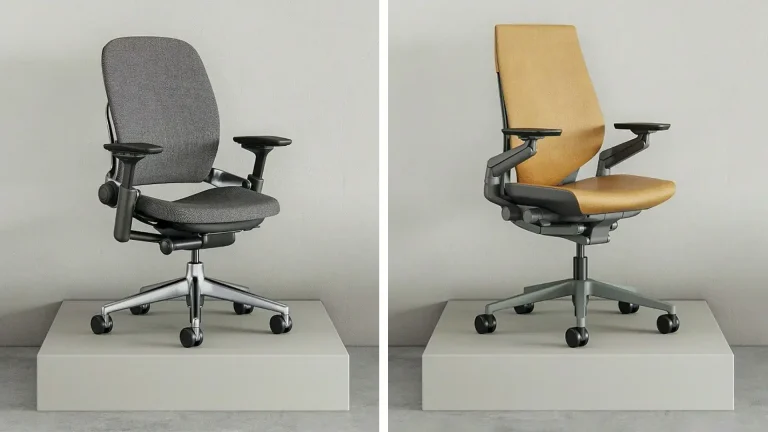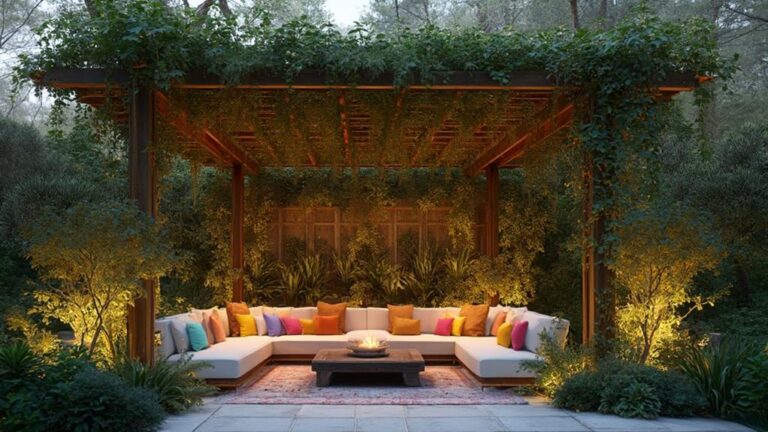What Size Posts Should Be Used for Your Pergola?
You're about to initiate a pergola adventure, and post size matters more than you think! For smaller 10×10 ft structures, go with 4×4 inch posts. But if you're dreaming big, like a 12×12 ft masterpiece, you'll want hefty 6×6 or even 8×8 inch posts. They give you that power look and hold up against the elements—trust me, your patio will thank you. Oh, and don't forget to reflect on what you'll hang on it; those plants and lights add weight! Stick around for some more juicy tips on selecting the right materials and installation hacks!
Key Takeaways
- Use 4×4 inch posts for smaller pergolas (10×10 ft) to support light structures.
- Opt for 6×6 inch posts for medium load pergolas (12×12 ft) providing better stability.
- For heavy loads or larger designs, select 8×8 inch posts to ensure structural integrity.
- Consider 4×6 inch posts for custom projects requiring tailored support and aesthetics.
- Always consult local building codes to ensure compliance and safety when choosing post sizes.
Purpose and Functionality
When you choose to add a pergola to your outdoor space, you're not just selecting a decorative feature; you're enhancing your living environment. Think of it as the cherry on top of your backyard sundae. A well-constructed pergola, like the BYD Windham Steel Pergola, offers durability and a modern aesthetic that seamlessly integrates with your outdoor design. It's not just about looking good, though— a pergola offers that oh-so-essential partial shade, letting you sip your iced tea without turning into a human puddle.
Now, if you're thinking small—like a cozy 10×10 ft structure—4×4 inch posts will do the trick. They're sturdy enough without being overkill. But if you're dreaming big, say 12×12 ft or more, you'll need those beefier 6×6 or 8×8 inch posts to keep everything standing tall. Plus, taller posts can give your climbing plants a chance to show off, which is basically a win-win for everyone involved.
And let's not forget, pergolas are like the "open concept" of outdoor structures—offering limited weather protection but still keeping you connected to nature. Just remember to check your local building codes; nobody wants a surprise visit from the "Pergola Police." So, time to elevate your backyard game!
Load Requirements

Understanding the load requirements for your pergola is essential for ensuring its stability and longevity. Think of it this way: you wouldn't want your dream outdoor spot crashing down because you decided to hang up that ridiculously heavy plant collection you can't live without, right?
You need to evaluate the weight of the pergola itself, plus any additional loads from hanging plants, lights, vines, and even your beloved outdoor furniture. Depending on the size and how much weight you plan to support, your post dimensions will typically range from 4×4 inches for the little guys to 6×6 inches or larger for the heavyweights. And if you live in a windy or snowy area, you'll want those sturdy posts to keep everything intact!
Here's a handy table to help you visualize your options:
| Post Size | Recommended Load |
|---|---|
| 4×4 | Light structures |
| 6×6 | Medium loads |
| 8×8 | Heavy loads |
| 4×6 | Custom projects |
| 6×8 | Extreme weather |
And don't forget about local building codes—they're there to keep you safe!
Aesthetic Considerations

After you've tackled the load requirements for your pergola, it's time to think about how those posts will look in your outdoor space. Let's face it, nobody wants a pergola that looks like it's been through a design disaster. For larger pergolas (think 12×12 ft or bigger), chunky posts like 6×6 or 8×8 inches not only keep things standing tall but also give your yard that "wow" factor. Additionally, opting for a durable option like the BYD Windham Steel Pergola guarantees you have a structure that withstands the elements while looking great.
On the flip side, if you're building a more petite structure, slimmer 4×4 posts can keep things sleek and stylish. It's all about balance, folks! Plus, the material matters too. Going for a rustic vibe? Chunky wood can do the trick. But if you're feeling modern, sleek metal or composite might be your jam.
And don't forget—keeping post sizes consistent throughout your pergola ties everything together nicely. Integrating with existing features, like fences or trellises, makes it all look intentional. Oh, and if you're into greenery, thinner posts are perfect for supporting climbing plants, adding an elegant touch without overdoing it. Happy designing!
Recommended Materials

Choosing the right materials for your pergola posts is essential for both functionality and style. You wouldn't want your beautiful pergola to collapse like a house of cards, right? For smaller structures, you can go for 90 x 90mm or 4×4 inch posts. But if you're dreaming big—think 6×6 inch posts for those larger pergolas that scream stability and support.
Treated pine is a solid choice since it's tough and resistant to decay. Seriously, who wants rotting wood ruining their backyard vibe? Make sure to look for H3 treatment, because it gives your posts a fighting chance against the elements. You know, keeping them from turning to mush.
And don't forget to anchor those posts like they're about to win a tug-of-war! Use heavy-duty hardware like Pryda Post Anchor Bolts or stirrups, and make sure they're embedded in concrete for that rock-solid support. If you want a little flair, laminated timber options like H3 Clear Primed FJ Laminated Pine can elevate your aesthetic game while keeping things structurally sound. Choose wisely, and your pergola will be the envy of the neighborhood!
Installation Guidelines

Once you've picked out the perfect materials for your pergola posts, it's time to focus on installation. You don't want your masterpiece to collapse at the first sign of a breeze, right? So, if you're building a smaller structure, go for those 90 x 90mm (about 4×4 inches) posts. For those grander designs, consider stepping up to 6×6 or even 8×8 posts. They're like the bodybuilders of the pergola world. Additionally, make sure that your chosen posts are constructed for durability, such as using 100% galvanized steel for superior strength and rust resistance.
Now, when it comes to digging, aim for at least 650mm deep holes. This isn't just for fun; it's all about stability against wind forces that could turn your beautiful pergola into a flying object. And please, embed those posts in concrete footings—this isn't an option; it's a must! Consult a structural engineer for the concrete design; they know their stuff.
Oh, and if you're anchoring onto concrete, remember to use proper post anchors. Leaving a 75mm gap under the post stirrup is essential too. Nobody wants water pooling and causing wood rot—trust me, that's a party crasher you don't need! So, get digging, and let's make this pergola stand tall!
Frequently Asked Questions
What Size Post Is Best for a Pergola?
When choosing a post size for your pergola, consider its dimensions and intended use. For smaller structures, 4×4 inch posts work well, while larger ones require 6×6 or 8×8 inch posts for better support.
What Size Are Pergola Poles?
If you're looking for pergola poles, you won't believe how essential they are! You'll typically find 4×4 inches for smaller designs, while larger ones demand hefty 6×6 or 8×8 inches for ultimate support and stability.
What Posts to Use for a Pergola?
When choosing posts for your pergola, consider its size and design. For smaller structures, 4×4 inch posts work well, while larger ones require 6×6 or 8×8 posts for stability and support in various conditions.
What Is the Standard Size of a Pergola Column?
You might think all pergola columns are the same, but they vary. Standard sizes usually range from 4×4 inches for smaller builds to 6×6 or 8×8 inches for larger ones, ensuring stability and strength.
Conclusion
So, when you're picking the right size posts for your pergola, just remember: it's not about going all medieval and building a fortress, but you do want something sturdy enough to hold up your dreams of lounging in style. Keep load requirements, aesthetics, and materials in mind, and you'll be on your way to creating a space that makes even the knights of yore jealous. Now grab those tools and get to work—your backyard deserves some love!





